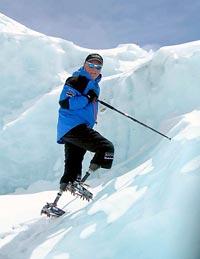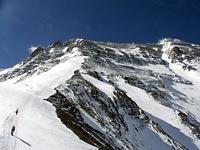Near the summit, David Sharp waved off fellow climbers: "I just want to sleep"

This is the second part of two parts on British climber David Sharp, who died on Mount Everest this year, leaving confusion and controversy about what had happened.
KATMANDU, NEPAL – Down from Everest's summit in the advance base camp, exhausted climbers returned to congratulations, drinks and blessed rest after the day's conquests.
But David Sharp, last spotted hours earlier near the mountain's pinnacle, was not among them that evening, May 14. Still, the experienced climbers who were his friends were not overly concerned.
Dave Watson assumed Sharp had crawled into an unoccupied tent at one of the high camps to rest. Sharp had turned around just shy of the summit twice before, so Watson knew the Briton was a smart climber. But he also knew Sharp thought of this as his last trip to Everest and was determined not to leave in defeat.
He remembered a remark Sharp had made while acclimatizing at the camp. Other climbers were snapping photos, but he told Watson he was saving his film.
"I've got all the pictures I need," Sharp had said, "except for the summit."
—
While many in the camp slept, climbers were moving high on Everest.
Mark Woodward, a guide for Himalayan Experience, was escorting a camera crew filming fellow New Zealander Mark Inglis' bid to become the first double amputee to reach the summit.
Shortly before 1 a.m., at about 27,760 feet, the group reached a rock alcove where Woodward knew they would find "Green Boots," the Indian climber who'd died there 10 years earlier. Woodward was shocked to find a second pair of boots protruding from the cave.
In the glare of his headlamp, Woodward could see a man, still clipped onto the red-and-blue guide rope, sitting with his arms wrapped around his knees. He had no oxygen mask on, and ice crystals had formed on his closed eyelashes. A cameraman yelled at him to get moving, but there was no response.
Believing the man in a hypothermic coma and beyond help, the group decided to move on.
About 20 minutes later, a group of Turkish climbers were waved off by Sharp. Others among the three dozen or so climbers attempting the summit that day assumed Sharp was "Green Boots," or didn't notice him at all.
Maxime Chaya had been first up the mountain that day and had passed the notch before the others, but had noticed no one.
Focused on his goal of becoming the first Lebanese citizen to summit Everest, Chaya reached the top at sunrise. The temperature was minus 36 degrees Fahrenheit as he and his Sherpa, Dorjee, headed back down.
They reached the rock cave around 9:30 a.m. This time, they could not miss Sharp. Chaya radioed expedition leader Russell Brice.
Sharp was unconscious and shivering violently, his teeth clenched. His nose had already turned black, his cheeks and lips were darkening.
He was hatless and without goggles, wearing just a thin pair of woolen gloves. In Sharp's pack, Chaya found only one oxygen bottle, the gauge on empty.
Chaya told Brice that Sharp's legs appeared to be frozen to the knees, his arms to the elbows. Dorjee had attempted to give the man oxygen, but there was no response.
Brice reminded Chaya that he had only about 90 minutes' worth of oxygen left. For nearly an hour, Chaya sat on a rock a few feet from Sharp, crying. Down at the camp, climbers clustered around the radios and wept.
Finally, Chaya stood up by the dying man and recited the Lord's Prayer. Finishing, Chaya made the sign of the cross and walked away.
—
It is not your body but your mind that carries you to the summit and back, according to one climber who was left for dead on Everest.
"Your body is exhausted hours before you reach the top," Beck Weathers wrote in a book recounting an expedition during the 1996 Everest season, the deadliest on record.
As for the dead or dying, Weathers wrote, "you leave them."
When the Turkish team, descending now, encountered Sharp again, it was already in rescue mode: a team member stricken with acute altitude sickness was being evacuated.
Eylem Elif Mavis and her Sherpa, Nima, tried to hook one of their own precious oxygen bottles to Sharp's regulator, but the device did not work.
They scanned the man's clothing for identification, hoping they could alert his team to mount a rescue, but found nothing. After radioing the ABC with the unidentified climber's condition and location, the group moved on.
Phurba Tashi, Brice's chief Sherpa, was descending with some others at 11:45 a.m. and was wearing a video camera on his helmet. Whether because of the rising temperature or the oxygen Dorjee had given him, Sharp was somehow able to speak.
"My name is David Sharp," he reportedly said. "I'm with Asian Trekking, and I just want to sleep."
The Sherpas administered oxygen and tried to get Sharp to his feet, but he kept collapsing.
They shifted Sharp a few feet into the sun, then headed down the mountain.
Back at the ABC, there was uncertainty: Besides Sharp, a Malaysian and an American, both first-timers, were overdue. Many were less concerned about the experienced Sharp.
Still, by the morning of May 16, confusion was giving gave way to serious concern.
It was then that Phurba, shown the passport retrieved from Sharp's camp tent, said yes, that was the man he'd seen.
But no new distress call was raised. Another Sherpa had already reported that the climber in the red boots was dead.
—
Did David Sharp have to die?
Nearly two weeks after Sharp's death, an Australian was rescued from even higher on the mountain.
Edmund Hillary was outraged after hearing that some climbers reported Sharp's condition during the ascent, but were told to continue to the summit. Suggesting he would have aborted his own historic climb to aid the Briton, Hillary declared that human life was "far more important than just getting to the top of a mountain."
Brice, who has initiated or taken part in 15 Everest rescue missions, insists he didn't know about Sharp's predicament until Sharp was already beyond rescue.
Inglis, who reached the summit on prosthetic legs, had said in a May broadcast interview that his team radioed to Brice about a stricken climber on their ascent and was told to go on. But the New Zealander told the AP this month that he was so focused on the challenges of the climb that "I may be mistaken."
Questions and recriminations about Sharp's death swirl like the plume of snow blowing from Everest's peak:
Why did no one try to administer high-altitude drugs to stimulate Sharp's breathing and relieve possible brain swelling? Could a couple of hours of high-flow oxygen have revived Sharp enough to get him moving? Why do people who passed Sharp within minutes of each other have significantly different recollections of his condition?
Watson said Sharp was just an hour's climb above the high camps for a strong Sherpa.
"It's too bad that none of the people who cared about David knew he was in trouble," Watson said.
Chaya offered condolences to Sharp's parents. But he said Sharp made grave errors by going alone with so little oxygen, without a radio and so late in the day.
"It almost looks like he had a death wish," he said.
Sharp's mother, Linda, did not blame Brice, Chaya or anyone else for her son's death. She thanked them for what they did do.
"Your only responsibility," she said, "is to save yourself — not to try to save anyone else."
—
Nine days after confirmation of Sharp's death, Christian Stangl, the Austrian climber who had befriended him, reached the spot where Sharp's body sat.
Someone had placed Sharp's red and blue rucksack on his chest, to cover his face. Stangl moved the pack, to see for himself if it was indeed Sharp — his eyes half open, his frozen hands at his sides, palms heavenward.
The Austrian replaced the pack, stepped over those red Millet boots and continued to the summit.
Did Sharp himself reach the summit? As with Everest pioneer George Leigh Mallory, no one is sure.
Sharp left no token at the top. No one has reported seeing him there. His camera, like Mallory's, is unaccounted for.
Jamie McGuinness, who accompanied Sharp on his first Everest climb, wants to believe his friend made it. Regardless, he thinks Sharp would be satisfied to know that, in a kind of frozen afterlife, his body will serve as a guidepost to the summit.
—
AP National Writer Allen G. Breed reported from the United States and Katmandu Correspondent Binaj Gurubacharya from Nepal. Also contributing to this report were AP writers Ray Lilley in Wellington, New Zealand, and Veronika Oleksyn in Vienna, Austria.

